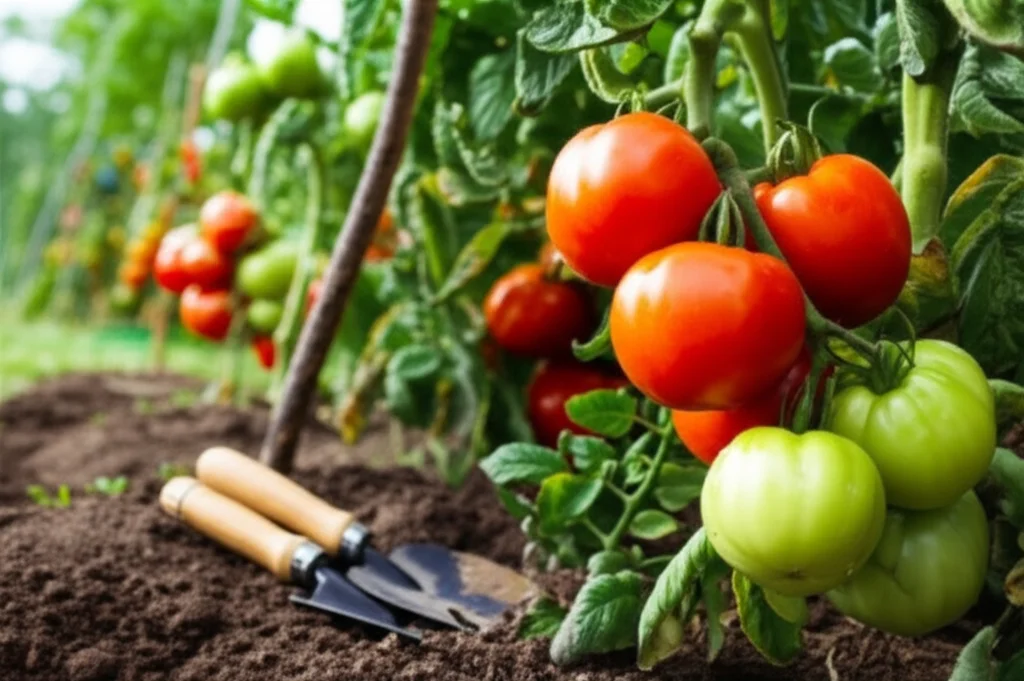This guide provides everything you need to know about planting tomatoes in North Carolina, from choosing the right variety to harvesting a bumper crop.

North Carolina’s climate offers a fantastic opportunity for growing delicious tomatoes. This guide will walk you through the entire process, ensuring your tomato-growing journey is a success.
JUMP TO TOPIC
Choosing the Right Tomato Variety for NC
North Carolina’s diverse climate, ranging from the mountains to the coast, allows for a wide variety of tomato cultivars. Choosing the right one depends on your specific location and the amount of sunlight your garden receives.
Early Season Varieties
Celebrity: A popular hybrid known for its disease resistance and high yields.
Early Girl: Produces medium-sized, flavorful fruits and is a good choice for shorter growing seasons. (Link to blog post about short-season gardening, if applicable)
Stupice: An extremely early-producing variety, perfect for those eager for the first taste of summer.
Mid-Season Varieties
Better Boy: A large, classic tomato with a balanced flavor, great for slicing.
Brandywine: Known for its exceptional flavor, although it can be prone to disease. (Link to blog post about tomato diseases, if applicable)
Roma: A paste tomato ideal for sauces and canning. (Link to blog post about canning tomatoes, if applicable)
Late-Season Varieties
Cherokee Purple: An heirloom variety with a unique, smoky flavor.
Mortgage Lifter: A large, pink tomato reputed to have earned its name by helping a farmer pay off his mortgage during the Depression.
German Johnson: Another heirloom with a rich, acidic taste.
Starting Seeds Indoors
Starting tomato seeds indoors 6-8 weeks before the last expected frost is crucial for maximizing your growing season. Here’s how to do it:
Use Seed Starting Mix: This provides the optimal blend of nutrients and drainage for young seedlings.
Plant Seeds Shallowly: Cover seeds with about ¼ inch of seed starting mix.
Provide Adequate Light: Use a grow light or place seedlings in a sunny window.
Keep Soil Moist: Water gently and consistently, avoiding overwatering. (Link to blog post about watering seedlings, if applicable)
Harden Off Seedlings: Gradually acclimate seedlings to outdoor conditions before transplanting.
Preparing Your Garden Bed
Tomatoes thrive in well-drained, fertile soil. Amend your soil with compost or aged manure to improve its structure and nutrient content. Choose a location that receives at least 6-8 hours of direct sunlight per day.
Soil pH: Tomatoes prefer a slightly acidic soil pH between 6.0 and 6.8.
Spacing: Space tomato plants 2-3 feet apart, depending on the variety.
Supporting Structures: Install stakes, cages, or trellises to support the plants as they grow.
Transplanting Seedlings
Once the danger of frost has passed, it’s time to transplant your seedlings into the garden.
Dig Deep Holes: Plant seedlings deeper than they were in their containers, burying the stem up to the first set of true leaves. This encourages strong root development.
Water Thoroughly: Water deeply after transplanting to help the roots establish themselves.
Caring for Your Tomato Plants
Consistent watering, fertilization, and pest control are essential for healthy tomato plants.
Watering: Water deeply and regularly, especially during dry periods. Aim for about 1-2 inches of water per week.
Fertilizing: Use a balanced fertilizer throughout the growing season. (Link to blog post about tomato fertilizers, if applicable)
Mulching: Apply a layer of mulch around the plants to suppress weeds, retain moisture, and regulate soil temperature.
Pest and Disease Control: Monitor your plants for common pests and diseases and take appropriate action. Link to resource about tomato pests on NC State Extension website
Harvesting and Enjoying Your Tomatoes
Tomatoes are typically ready for harvest 60-80 days after transplanting, depending on the variety. Harvest when fruits are fully colored and slightly soft to the touch.
FAQs about Planting Tomatoes in NC
Q: When is the best time to plant tomatoes in NC?
A: After the last expected frost, which typically falls between late March and mid-May depending on your location within the state.
Q: What are the most common tomato problems in NC?
A: Blossom-end rot, early blight, and late blight are common fungal diseases. Insect pests include tomato hornworms and aphids.
Q: How can I protect my tomatoes from frost?
A: Cover plants with row covers or blankets if a late frost is expected.
Q: Do I need to prune my tomato plants?
A: Pruning indeterminate varieties can improve airflow and increase fruit production.
Q: Can I grow tomatoes in containers in NC?
* A: Yes, many tomato varieties thrive in containers, making them ideal for patios and balconies. Choose a large container (at least 5 gallons) and use a well-draining potting mix.
Conclusion
Planting tomatoes in North Carolina can be a rewarding experience. By following these guidelines and choosing the right varieties for your area, you can enjoy a bountiful harvest of delicious, homegrown tomatoes. From selecting the perfect seedling to savoring the ripe fruit, the journey of growing your own tomatoes is one filled with flavor and satisfaction. Don’t forget to check out other helpful resources like the NC State Extension Gardener Handbook for more detailed information specific to your area.

